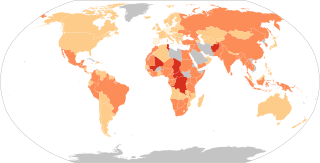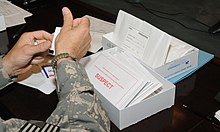
The Rape, Abuse & Incest National Network (RAINN) is an American nonprofit anti-sexual assault organization, the largest in the United States. RAINN operates the National Sexual Assault Hotline, as well as the Department of Defense Safe Helpline, and carries out programs to prevent sexual assault, help survivors, and ensure that perpetrators are brought to justice through victim services, public education, public policy, and consulting services.
Sexual assault is an act in which one intentionally sexually touches another person without that person's consent, or coerces or physically forces a person to engage in a sexual act against their will. It is a form of sexual violence that includes child sexual abuse, groping, rape, drug facilitated sexual assault, and the torture of the person in a sexual manner.
Differential extraction refers to the process by which the DNA from two different types of cells can be extracted without mixing their contents. The most common application of this method is the extraction of DNA from vaginal epithelial cells and sperm cells from sexual assault cases in order to determine the DNA profiles of the victim and the perpetrator. Its success is based on the fact that sperm cells pack their DNA using protamines which are held together by disulfide bonds. The protamines sequester DNA from spermatozoa, making it more resilient to DNA extraction than DNA from epithelial cells.
Rape crisis centers in the United States, usually capitalized as Rape Crisis Center and often abbreviated as RCC, are community-based organizations affiliated with the anti-rape movement in the U.S. Rape crisis centers in other countries offer similar services, but have different histories and vary in their organizational structure.
A crime laboratory, often shortened to crime lab, is a scientific laboratory, using primarily forensic science for the purpose of examining evidence from criminal cases.

Louis R. Vitullo was a Chicago police sergeant and chief microanalyst at the city's crime lab.

Rape is a type of sexual assault involving sexual intercourse or other forms of sexual penetration carried out against a person without their consent. The act may be carried out by physical force, coercion, abuse of authority, or against a person who is incapable of giving valid consent, such as one who is unconscious, incapacitated, has an intellectual disability, or is below the legal age of consent. The term rape is sometimes used interchangeably with the term sexual assault.
Kym Loren Worthy is an American lawyer and politician serving as the prosecutor of Wayne County, Michigan since 2004. A member of the Democratic Party, she is the first African-American woman to serve as a county prosecutor in Michigan. She is most noted for prosecuting then-Detroit Mayor Kwame Kilpatrick at the beginning of March 2008.

The Debbie Smith Act of 2004 provides United States federal government grants to eligible states and units of local government to conduct DNA analyses of backlogged DNA samples collected from victims of crimes and criminal offenders. The Act expands the Combined DNA Index System (CODIS) and provides legal assistance to survivors of dating violence. Named after sexual assault survivor Debbie Smith, the Act was passed by the 108th Congress as part of larger legislation, the Justice for All Act of 2004, and signed into law by President George W. Bush on October 30, 2004. The Act amended the DNA Analysis Backlog Elimination Act of 2000, the DNA Identification Act of 1994, the Violence Against Women Act of 2000, and the Uniform Code of Military Justice. The Act was reauthorized in 2008, extending the availability of DNA backlog reduction program grants, DNA evidence training and education program grants, and sexual assault forensic exam program grants through fiscal year 2014.
A serial rapist is someone who commits multiple rapes, whether with multiple victims or a single victim repeatedly over a period of time. Some serial rapists target children. The terms sexual predator, repeat rape and multiple offending can also be used to describe the activities of those who commit a number of consecutive rapes, but remain unprosecuted when self-reported in research. Others will commit their assaults in prisons. In some instances, a group of serial rapists will work together. These rapists can have a pattern of behavior that is sometimes used to predict their activities and aid in their arrest and conviction. Serial rapists also differ from one time offenders because "serial rapists more often involved kidnapping, verbally and physically threatening the victims, and using or threatening the use of weapons."
Rape investigation is the procedure to gather facts about a suspected rape, including forensic identification of a perpetrator, type of rape and other details.
Natasha's Justice Project (NJP) is a 501(c)(3) non-profit organization that seeks to end the nation's current rape kit backlog crisis and empower and assist survivors of sexual assault through travel grants to testify at their trials. NJP was founded by Natasha S. Alexenko, a victim and survivor of sexual assault, in hopes of exposing and eliminating the current rape kit backlog that exists in public municipalities throughout the United States. NJP empowers survivors of sexual assault by getting their rape kits off the shelves and tested so that their perpetrator(s) are brought to justice.
A Sexual Assault Nurse Examiner (SANE) is a qualification for forensic nurses who have received special training to conduct sexual assault evidentiary exams for rape victims in the United States.
Forensic nursing is defined as the application of the nursing process to public or legal proceedings, and the application of forensic health care in the scientific investigation of trauma and/or death related to abuse, violence, criminal activity, liability, and accidents.

"Behave" is the third episode of the twelfth season of the police procedural Law & Order: Special Victims Unit and the 251st episode overall. It originally aired on NBC in the United States on September 29, 2010. The episode, which was inspired by rape kit backlogs, follows Detective Olivia Benson helping a repeat rape victim stand up to her attacker, and finding the evidence to put him away. Meanwhile, the rapist could possibly walk because the evidence against him has been misplaced, poorly stored and even accidentally destroyed.

The Survivors' Bill of Rights Act of 2016 is a landmark civil rights and victims rights legislation in the United States that establishes, for the first time, statutory rights in federal code for survivors of sexual assault and rape. The law impacts nearly 25 million estimated rape survivors in the United States. This legislation was passed by the United States Congress in September 2016 and signed into law by US President Barack Obama on October 7, 2016.
After a sexual assault or rape, victims are often subjected to scrutiny and, in some cases, mistreatment. Victims undergo medical examinations and are interviewed by police. If there is a criminal trial, victims suffer a loss of privacy, and their credibility may be challenged. Victims may also become the target of slut-shaming, abuse, social stigmatization, sexual slurs and cyberbullying. These factors, contributing to a rape culture, are among some of the reasons that may contribute up to 80% of all rapes going unreported in the U.S, according to a 2016 study done by the U.S. Department of Justice.
Rebecca Campbell is a professor of psychology at Michigan State University. She is known for her research pertaining to sexual assault and violence against women and children and the effects of treatment by law enforcement and medical staff on victims' psychological and physiological well-being. Campbell has been involved in criminal justice research on the investigation of Detroit's untested rape kits, wherein DNA evidence obtained in thousands of rape kits was left in storage and not analyzed. She has received numerous awards for her work including the Society for the Psychological Study of Social Issues Louise Kidder Early Career Award (2000), the American Psychological Association (APA) Early Career Award for Distinguished Contributions to Psychology in the Public Interest (2008), the APA Division 27 Council on Educational Program's Excellent Educator Award (2015), and the U.S. Department of Justice Vision 21 Crime Victims Research Award (2015).

Kelly Moller is an American politician serving in the Minnesota House of Representatives since 2019. A member of the Minnesota Democratic–Farmer–Labor Party (DFL), Moller represents District 40A in the north-central Twin Cities metropolitan area, which includes the cities of Mounds View and Shoreview and parts of Ramsey County, Minnesota.

Martha "Marty" Goddard was an American crime victims' advocate who was instrumental in developing the rape test kit, used to methodically collect forensic evidence from survivors of rape.







